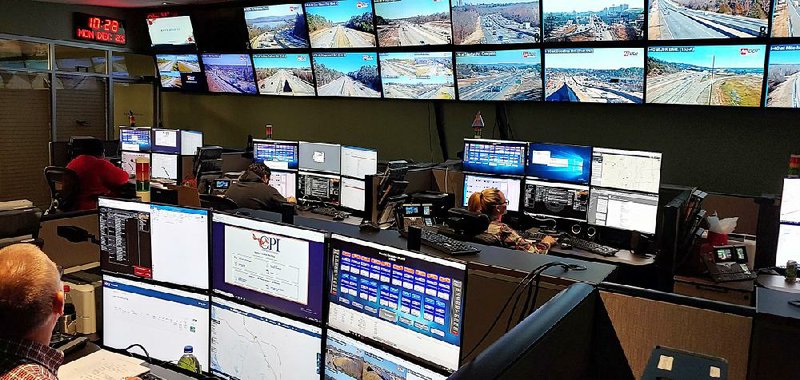Video feeds from nearly 200 mostly high-definition cameras installed along the state's busiest travel corridors end up on a bank of 20 big television screens in the basement of the Arkansas Department of Transportation's headquarters in Little Rock.
As many as five people monitor the traffic 24 hours a day, seven days a week in the agency's Traffic Management Center.
The center still has room to grow in its capabilities, which will eventually include a stand-alone building, perhaps on a 3-acre site near the agency headquarters that the department recently acquired for $1.4 million.
It is part of a larger strategy by state departments across the country to employ traffic operations that "optimize the performance of the existing transportation network," according to Metroplan, the long-range transportation planning agency for Central Arkansas, which long has advocated the use of smart technology to manage traffic to avoid or delay spending millions more dollars to expand the transportation network.
"The goal is to get the best performance out of the facilities we already have," said Joseph Tucker, the intelligent transportation systems engineer for the Department of Transportation. Earlier this month, he briefed the Metroplan board of directors on the Traffic Management Center.
To this point, and for some time in the future, the center's staff is limited to identifying and responding to incidents -- such as crashes, flooding or other events -- to safely manage traffic, mitigate the potential for additional crashes and quickly restore traffic flow.
The center uses a variety of platforms -- such as the department's iDriveArkansas.com website and social media, as well as dynamic message boards and radio dispatches -- to distribute up-to-date traffic information to the driving public, other department personnel, first responders, other state agencies and the media.
The center's partners include the Arkansas Highway Police, a department division; the Arkansas State Police; local police, fire departments and ambulance crews; personnel in the department's 12 districts; and the Arkansas Department of Emergency Management, according to Tucker.
The partners also include the department's maintenance division and public information office.
"The primary functions we do now primarily are traffic incident detection and management," Tucker told the Metroplan board. "We also provide real-time traveler information, highway police dispatch."
The center also monitors the weather, especially in cases when flash flooding or snow and ice pose a risk.
The staff has a variety of tools to collect, process and distribute traffic data.
"One of our biggest assets is our cameras, our fleet of cameras, which is growing," Tucker said. "A picture is worth a thousand words. If something is going on, we will see if we have a camera nearby, we'll turn to see what's going on."
The staff also monitors social media tools such as Waze, a GPS navigation app that collects data, including users' speeds, to provide real-time traffic information. Information obtained from Waze is independently verified before the staff acts on it.
The center was announced more than two years ago.
At the time, the department had developed a network of 42 closed-circuit television cameras, 54 dynamic message boards and 11 highway advisory radio stations. But using them to collect and disseminate information was cumbersome, often involving calling a technician who used a laptop to, for example, put time-critical information on a message board.
"None of it was tied together," said Danny Straessle, the department spokesman.
The center was initially housed in the Arkansas Highway Police radio room. The division's dispatchers still share space in the center.
To accommodate the center, the department removed part of its cafeteria to build out the radio room; overhaul and expand the workstations; and add new furnishings, lighting and equipment at a cost estimated at the time to be $600,000.
A study that the department commissioned estimated the software needed to integrate the monitoring and communication systems would cost about $1.3 million. An exact cost was unavailable last week.
The integrated system can allow for almost instantaneous communication to the traveling public, Tucker said.
He said he encourages the staff to be proactive in finding traffic incidents.
"I want them to find an incident before anybody else knows about it and start reaching out to our first responders and stakeholders," he said.
In the not-too-distant future, the center plans to be actively controlling traffic rather than responding.
The department has plans to make improvements to a portion of Interstate 430 that will allow the shoulder on the bridge over the Arkansas River to be used as an additional lane during peak travel hours.
Agency officials see using a shoulder as a part-time travel lane, which experts refer to as a "dynamic shoulder lane," as a cost-effective way to mitigate congestion.
The estimated cost is $15 million, well below the more than $100 million needed to build a new bridge.
The department's Traffic Management Center will use cameras, changeable message boards and overhead lane-control signs to control use of the part-time travel lane. A green check would indicate when the lane is in use; a red X would indicate its closure.
The agency believes the change can reduce delays and improve traffic reliability while it responds in real time to forecast or observed traffic conditions, as well as accidents.
Casey Covington, the Metroplan deputy director, said the Traffic Management Center is already paying dividends.
"The role of technology in proving regional transportation solutions cannot be overstated," he said. "It is exciting to see the advances that ArDOT is making with its TMC to accommodate technology's expanding role in transportation. Technology will continue to shape our region and provide transportation solutions in the future."
Metro on 12/30/2019
